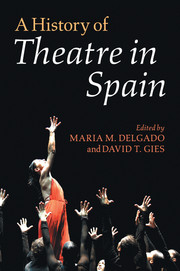Book contents
- Frontmatter
- Contents
- Illustrations
- Contributors
- Acknowledgements
- Introduction
- 1 The challenges of historiography
- 2 Lope de Vega, Calderón de la Barca and Tirso de Molina
- 3 The world as a stage
- 4 Playing the palace
- 5 The art of the actor, 1565–1833
- 6 Theatrical infrastructures, dramatic production and performance, 1700–1759
- 7 Popular theatre and the Spanish stage, 1737–1798
- 8 Theatre of the elites, neoclassicism and the Enlightenment, 1750–1808
- 9 Actors and agency in the modern era, 1801–2010
- 10 Zarzuela
- 11 Nineteenth-century Spanish theatre
- 12 Copyright, buildings, spaces and the nineteenth-century stage
- 13 Modernism and the avant-garde in fin-de-siècle Barcelona and Madrid
- 14 Continuity and innovation in Spanish theatre, 1900–1936
- 15 Theatrical activities during the Spanish Civil War, 1936–1939
- 16 Theatre, colonialism, exile and the Americas
- 17 Theatre under Franco (1939–1975)
- 18 Flamenco
- 19 Nationalism, identity and the theatre across the Spanish state in the democratic era, 1975–2010
- 20 Directors and the Spanish stage, 1823–2010
- 21 This evolution is still ongoing
- 22 Theatre as a process of discovery
- 23 Theatre is the art of the future
- Select bibliography
- Index
- References
10 - Zarzuela
High art, popular culture and music theatre
Published online by Cambridge University Press: 05 June 2012
- Frontmatter
- Contents
- Illustrations
- Contributors
- Acknowledgements
- Introduction
- 1 The challenges of historiography
- 2 Lope de Vega, Calderón de la Barca and Tirso de Molina
- 3 The world as a stage
- 4 Playing the palace
- 5 The art of the actor, 1565–1833
- 6 Theatrical infrastructures, dramatic production and performance, 1700–1759
- 7 Popular theatre and the Spanish stage, 1737–1798
- 8 Theatre of the elites, neoclassicism and the Enlightenment, 1750–1808
- 9 Actors and agency in the modern era, 1801–2010
- 10 Zarzuela
- 11 Nineteenth-century Spanish theatre
- 12 Copyright, buildings, spaces and the nineteenth-century stage
- 13 Modernism and the avant-garde in fin-de-siècle Barcelona and Madrid
- 14 Continuity and innovation in Spanish theatre, 1900–1936
- 15 Theatrical activities during the Spanish Civil War, 1936–1939
- 16 Theatre, colonialism, exile and the Americas
- 17 Theatre under Franco (1939–1975)
- 18 Flamenco
- 19 Nationalism, identity and the theatre across the Spanish state in the democratic era, 1975–2010
- 20 Directors and the Spanish stage, 1823–2010
- 21 This evolution is still ongoing
- 22 Theatre as a process of discovery
- 23 Theatre is the art of the future
- Select bibliography
- Index
- References
Summary
In 1888 in Turin, Italy, Friedrich Nietzsche wrote the following about La Gran Vía (1886), one of the best-known pieces of the zarzuela repertoire:
[It] is the strongest thing that I have heard and seen . . . Cenerentola [by Rossini] is a thousand times too kindhearted when compared with the Spaniards . . . Offenbach's Schöne Helena (The Beautiful Helen) coming after it was a sorry falling-off. I left.
Nietzsche regarded the music by Federico Chueca (1846–1908) and Joaquín Valverde (1846–1910), and the libretto by Felipe Pérez y González (1854–1910) as among the finest operatic achievements of the nineteenth century. The grace and popular cheerfulness of the so-called revista madrileña cómico-lírica, fantástico-callejera (Madrid comic-lyric fantastic-streetwise revue) conformed both to his theory of vitalism and his radical ideas on mankind. Nietzsche's words speak of a time in which the Spanish musical theatre was thriving and securing a place within the wider European operatic repertoire. In the twenty-first century, with no new zarzuelas premiered for over fifty years, there might be a case to be made that the genre has effectively exhausted its own creative means and now remains a historical relic.
- Type
- Chapter
- Information
- A History of Theatre in Spain , pp. 193 - 210Publisher: Cambridge University PressPrint publication year: 2012
References
- 1
- Cited by

